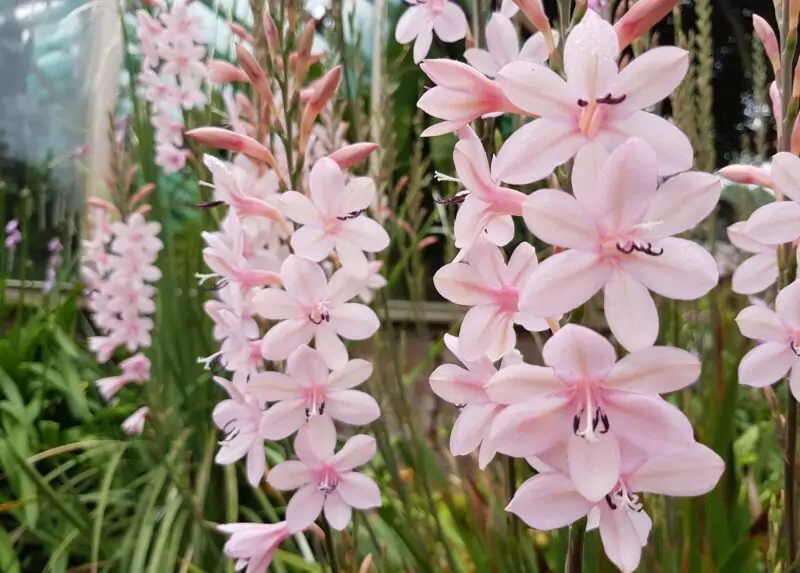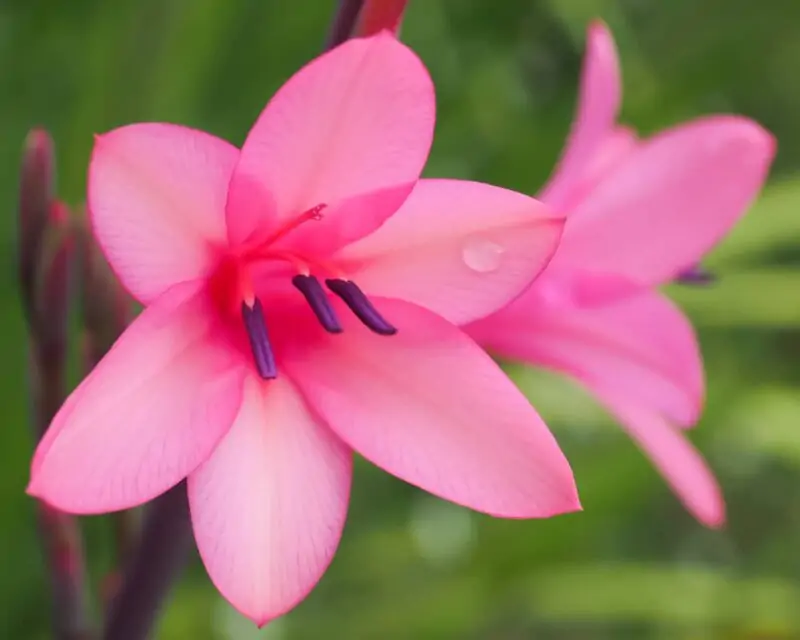A Gardener’s Guide to Growing Watsonia Borbonica and Bugle Lily

Hello there, fellow flower enthusiasts! Today, let’s talk about a perennial favorite, the wonderful Watsonia. It’s a captivating bloom that takes its name from the celebrated botanist, Sir William Watson. A spectacular display of widely grown flowers that can transform even the most nondescript clump of well-drained soil into a beautiful garden. And folks, it’s not just about the flowering bulbs. With Watsonia, it’s about the joy of watching the miracle of growth, from a tiny corm to a stately flower. I’m excited to share this journey with you, so let’s get our green thumbs ready and dive in!
Unfolding Watsonia: Types and Characteristics
Watsonia Borbonica: A Closer Look
Let’s start with the renowned Watsonia Borbonica. Often seen painting gardens in striking hues of pink or orange, this variety is a hit amongst gardening enthusiasts. Its flowers come to life in late spring to early summer, making it a joy to watch in an otherwise tepid climate. What’s more, its tall, sword-shaped foliage stands out, adding an intriguing textural element to any garden.
Goldblatt: An Uncommon Variety of Watsonia
Enter the rare Goldblatt Watsonia. It’s no ordinary bloom; this variety is named after botanist Peter Goldblatt and has quite an unconventional charm. Known to bloom in the late summer, its pristine white flowers are a spectacle in any garden. Like a rare gem, the Goldblatt Watsonia requires little care. It adores basking in full sun and well-drained soil. Care for it right; when blooming has finished, it will reward you with a stunning display of graceful plants that can make any gardener swell with pride!
Bulbil Bugle-Lily: Characteristics and Identification
And lastly, we have the Bulbil Bugle-Lily, another fascinating variety of Watsonia. This plant truly embodies the miracle of life, with tiny bulbils sprouting along its stems that eventually fall off and create new plants. It’s nature’s own way of keeping the family growing! When it comes to flowers, the Bulbil Bugle-Lily does not disappoint either. Its vibrant red blooms are sure to captivate anyone who lays eyes on them. It makes a perfect cut flower or addition to any garden, lending it a touch of drama and color.
How to Grow Watsonias: A Step-by-Step Guide

Selecting the Ideal Site for Growing Watsonia
First the good news, these plants are easy to grow, so long as you do your due diligence. Choosing the right spot for your Watsonia is crucial. These sun-loving beauties thrive best in full sun and well-drained soil. They’re not fans of getting their “feet” too wet. So, you’ll want to pick a place where water doesn’t pool. Watsonias are a bit fussy about their climate. They prefer areas that can offer them their daily dose of sunlight without drenching them in the rain. A little bit of compost can be a great help in preparing the perfect bed during the growing season.
Planting Watsonia Corms: A Practical Approach
Ready to get your hands dirty? Good! Because it’s time to plant those Watsonia corms. Imagine them as tiny life capsules, ready to burst forth with vibrant colors. These little fellows, much like tulip bulbs, are planted in late spring. Be careful to plant them with the pointed end facing upwards. And remember, they like to snuggle up under a good 2.5 inches of soil cover before they get to work.
Watsonia Care: Watering, Fertilizing, and Pruning
Taking care of Watsonias is a labor of love. They enjoy a good drink but remember, moderation is key! Overwatering can lead to root rot, so be mindful of that. If you’ve got summer rainfall, it should be enough to keep them happy. As for feeding, a bit of slow-release fertilizer at planting time will do wonders. So, when the foliage dies back after bloom, start pruning, and cut the flower stalks as necessary to encourage new growth. It’s all part of the cycle of life in the garden!
Overcoming Challenges of Growing Watsonia
Common Diseases and Pests
Even with the best care, our tall perennials can sometimes run into trouble. They’re susceptible to rust, a fungal disease that can leave your plants looking less than their best. Pests can also pose a challenge, particularly the Watsonia beetle, which seems to have a taste for its leaves. But don’t worry; a bit of insecticide should send these unwelcome guests packing.
Solutions to Common Watsonia Growing Problems
Problems with Watsonia’s growth can often be traced back to the basics. If your plants are looking unhappy, it might be due to overwatering or poor soil conditions. Similarly, if the leaves are yellowing, it could be a sign that your Watsonia is getting too much water. Cutting back on watering can help solve this issue. If the soil is soggy, it might be time to replant your Watsonia in a more suitable location. It’s all about understanding what your plant needs and making those small tweaks to ensure it thrives.
FAQs
If your tall flowers aren’t blooming, it could be due to a few factors. Maybe they’re not getting enough sun, or perhaps the soil isn’t draining well. Or it could simply be that they need a bit more time. Remember, patience is a virtue when it comes to gardening!
Ah, propagation, the joy of creating more beauty! To propagate Watsonia from corms, simply dig up the mature corms after the blooming season. You’ll notice tiny cormlets attached. These corms should be planted divided every few feet in 2-3 inches of deep, well-drained soil under full sun. And voila! You’ll have new Watsonia plants in no time, and can expect a mid- to late spring bloom. There’s nothing better than spring-blooming Watsonias to welcome you to the new year.
Well, safety first, right? The good news here is that Watsonias are not known to be toxic to pets. But as with all plants, it’s best to discourage your furry friends from munching on them. After all, these rose-pink beauties are for your eyes, not Fido’s belly!
Conclusion
As we wrap up our journey through the Watsonia wonderland, I hope you’re as enamored with this bulbous beauty as I am. From tall stems and captivating blooms to the fascinating process of growth from a humble corm, they offer a gardening experience that is both delightful and rewarding. Whether you’re a seasoned gardener or a budding green thumb, this vibrant flower is a fantastic addition to any garden. So go on, let him work his magic in your personal green space, and bask in the joy of nurturing nature. Happy gardening!